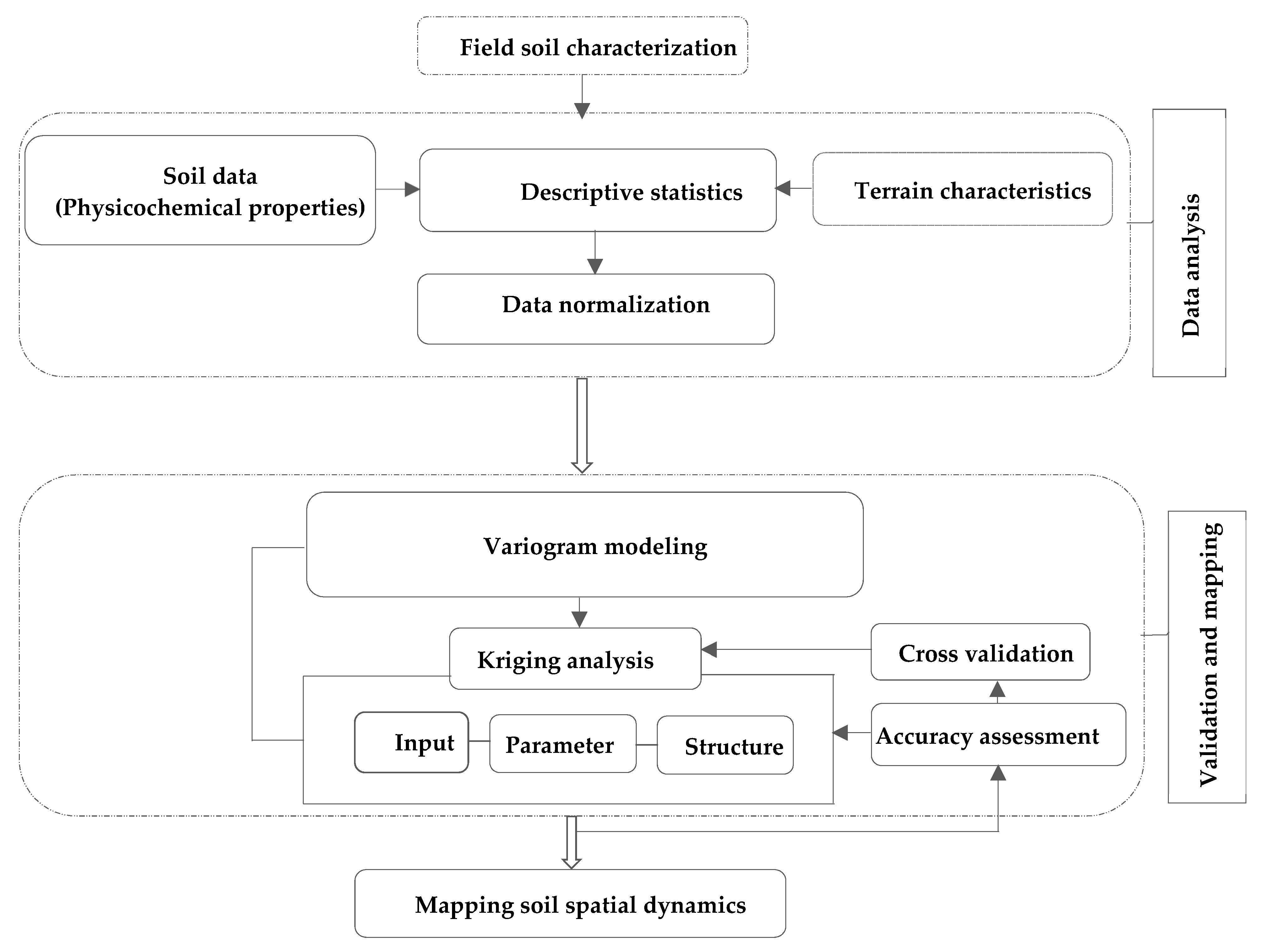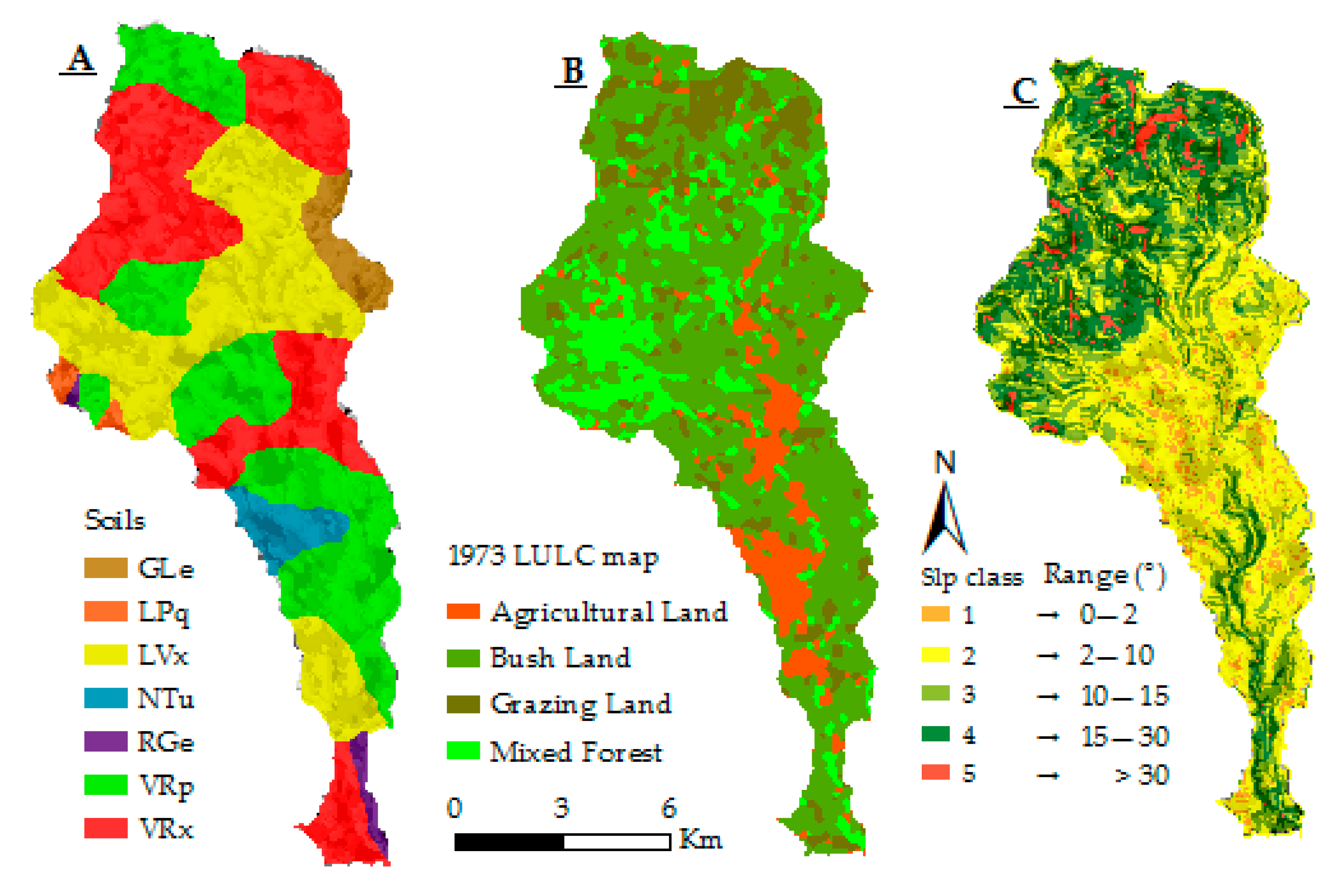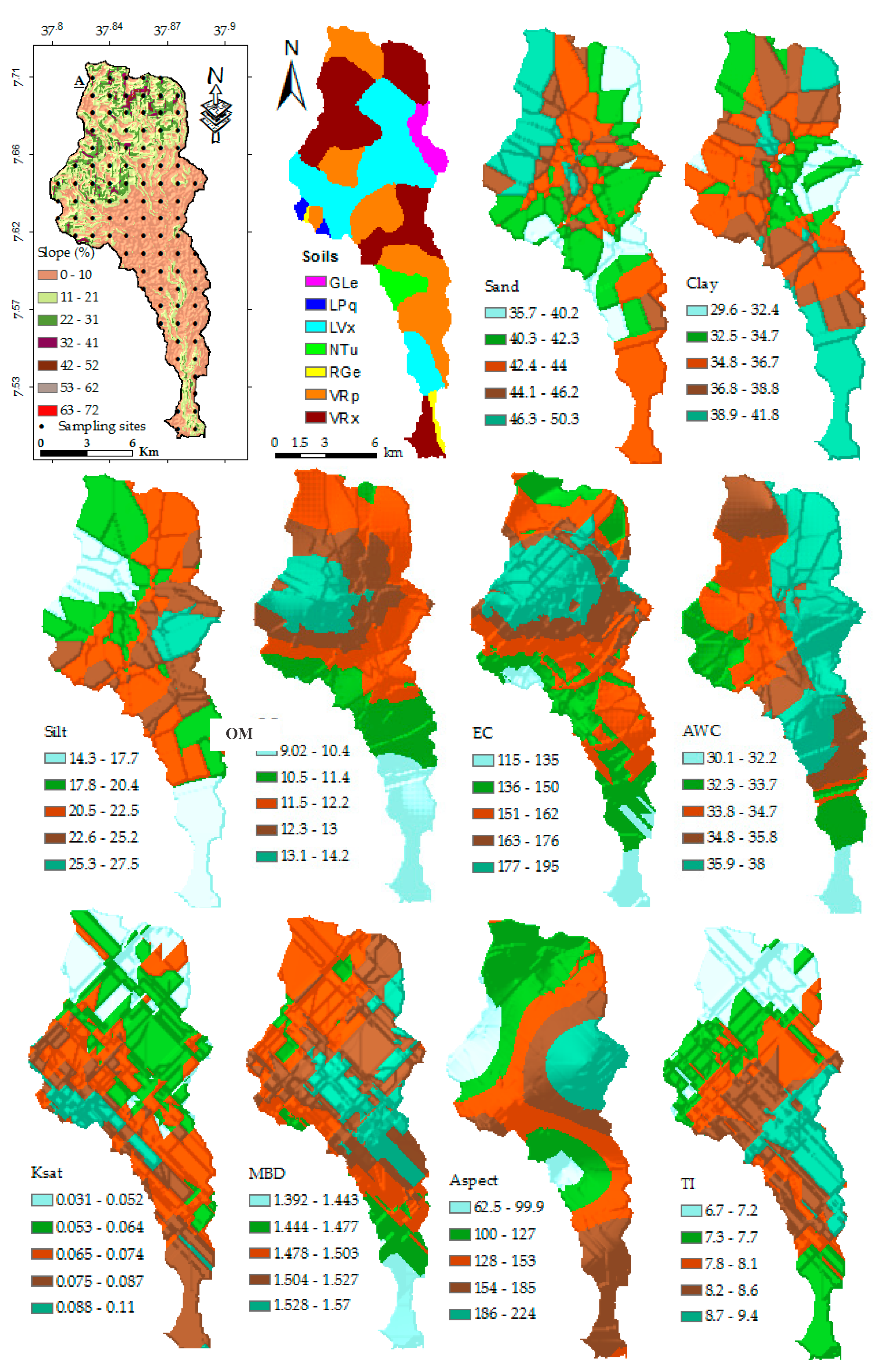Terrain Effects on the Spatial Variability of Soil Physical and Chemical Properties
Abstract
:1. Introduction
2. Materials and Methods
2.1. Site Description
2.2. Soil Survey and Mapping
Spatial Mapping of Topography Index
2.3. Geostatistical Analysis
3. Results and Discussion
3.1. Soil Spatial Analysis, Classification, and Mapping
3.2. Soil Wetness and Dryness with Topography
3.3. Soil Topography Relationships
3.4. Soil, Topography and Land Use Relationships
Slope Effects on Soil Physicochemical Properties and Land Cover Distribution
4. Conclusions
Supplementary Materials
Author Contributions
Funding
Acknowledgments
Conflicts of Interest
References
- Jiang, S.-H.; Huang, J.; Yao, C.; Yang, J. Quantitative risk assessment of slope failure in 2-D spatially variable soils by limit equilibrium method. Appl. Math. Model. 2017, 47, 710–725. [Google Scholar] [CrossRef]
- Jiang, S.-H.; Huang, J.-S. Efficient slope reliability analysis at low-probability levels in spatially variable soils. Comput. Geotech. 2016, 75, 18–27. [Google Scholar] [CrossRef]
- Kreznor, W.R.; Olson, K.R.; Banwart, W.L.; Johnson, D.L. Soil, landscape, and erosion relationships in a northwest Illinois watershed. Soil Sci. Soc. Am. J. 1989, 53, 1763–1771. [Google Scholar] [CrossRef]
- Ayele, G.T.; Tebeje, A.K.; Demissie, S.S.; Belete, M.A.; Jemberrie, M.A.; Teshome, W.M.; Mengistu, D.T.; Teshale, E.Z. Time Series Land Cover Mapping and Change Detection Analysis Using Geographic Information System and Remote Sensing, Northern Ethiopia. Air Soil Water Res 2018, 11. [Google Scholar] [CrossRef] [Green Version]
- Asres, R.S.; Tilahun, S.A.; Ayele, G.T.; Melesse, A.M. Analyses of Land Use/Land Cover Change Dynamics in the Upland Watersheds of Upper Blue Nile Basin. Spring Geogr 2016. [Google Scholar] [CrossRef]
- Ceddia, M.B.; Vieira, S.R.; Villela, A.L.O.; Mota, L.D.S.; Anjos, L.H.C.D.; Carvalho, D.F.D. Topography and spatial variability of soil physical properties. Sci. Agric. 2009, 66, 338–352. [Google Scholar] [CrossRef] [Green Version]
- WeillA, M.; VieiraB, S.; SparovekC, G. Assessment of the spatial relationship between soil properties and topography over a landscape. In Proceedings of the 19th World Congress of Soil Science, Soil Solutions for a Changing World, Brisbane, Australia, 1–6 August 2010; pp. 20–23. [Google Scholar]
- Vauclin, M.; Vieira, S.; Vachaud, G.; Nielsen, D. The Use of Cokriging with Limited Field Soil Observations 1. Soil Sci. Soc. Am. J. 1983, 47, 175–184. [Google Scholar] [CrossRef]
- Saxton, K.E.; Rawls, W.J. Soil water characteristic estimates by texture and organic matter for hydrologic solutions. Soil Sci. Soc. Am. J. 2006, 70, 1569–1578. [Google Scholar] [CrossRef] [Green Version]
- Cosby, B.; Hornberger, G.; Clapp, R.; Ginn, T. A statistical exploration of the relationships of soil moisture characteristics to the physical properties of soils. Water Resour. Res. 1984, 20, 682–690. [Google Scholar] [CrossRef] [Green Version]
- Rawls, W.; Brakensiek, D. Estimation of soil water retention and hydraulic properties. In Unsaturated Flow in Hydrologic Modeling; Springer: Berlin, Germany, 1989; pp. 275–300. [Google Scholar]
- Wösten, J.; Lilly, A.; Nemes, A.; Le Bas, C. Development and use of a database of hydraulic properties of European soils. Geoderma 1999, 90, 169–185. [Google Scholar] [CrossRef]
- Abdelbaki, A.M.; Youssef, M.A.; Naguib, E.M.; Kiwan, M.E.; El-giddawy, E.I. Evaluation of pedotransfer functions for predicting saturated hydraulic conductivity for US soils. In Proceedings of the 2009, Reno, NV, USA, 21–24 June 2009; p. 1. [Google Scholar]
- Harrison, K.W.; Kumar, S.V.; Peters-Lidard, C.D.; Santanello, J.A. Quantifying the change in soil moisture modeling uncertainty from remote sensing observations using Bayesian inference techniques. Water Resour. Res. 2012, 48, 11. [Google Scholar] [CrossRef]
- Gijsman, A.; Jagtap, S.; Jones, J. Wading through a swamp of complete confusion: How to choose a method for estimating soil water retention parameters for crop models. Eur. J. Agron. 2002, 18, 77–106. [Google Scholar] [CrossRef]
- Luo, Y.; Yang, S.; Zhao, C.; Liu, X.; Liu, C.; Wu, L.; Zhao, H.; Zhang, Y. The effect of environmental factors on spatial variability in land use change in the high-sediment region of China’s Loess Plateau. J. Geogr. Sci. 2014, 24, 802–814. [Google Scholar] [CrossRef] [Green Version]
- Ayele, G.T.; Demissie, S.S.; Tilahun, S.A.; Jeong, J.; Jemberie, M.A. Assessing drought severity from multi-temporal GIMMSNDVI and rainfall interactions. In Proceedings of the 36th Hydrology and Water Resources Symposium: The art and science of water, Barton, Australia, 2015; p. 306. [Google Scholar]
- O’Geen, A. Soil water dynamics. Nat. Educ. Knowl. 2012, 3, 12. [Google Scholar]
- Quan, B.; Römkens, M.; Li, R.; Wang, F.; Chen, J. Effect of land use and land cover change on soil erosion and the spatio-temporal variation in Liupan Mountain Region, southern Ningxia, China. Front. Environ. Sci. Eng. China 2011, 5, 564–572. [Google Scholar] [CrossRef]
- Opršal, Z.; Šarapatka, B.; Kladivo, P. Land-use changes and their relationships to selected landscape parameters in three cadastral areas in Moravia (Czech Republic). Morav. Geogr. Rep. 2013, 21, 41–50. [Google Scholar] [CrossRef] [Green Version]
- Ayele, G.T.; Demessie, S.S.; Mengistu, K.T.; Tilahun, S.A.; Melesse, A.M. Multitemporal Land Use/Land Cover Change Detection for the Batena Watershed, Rift Valley Lakes Basin, Ethiopia. Spring Geogr 2016. [Google Scholar] [CrossRef] [Green Version]
- Pachepsky, Y.A.; Timlin, D.; Rawls, W. Soil water retention as related to topographic variables. Soil Sci. Soc. Am. J. 2001, 65, 1787–1795. [Google Scholar] [CrossRef]
- Rezaei, S.A.; Gilkes, R.J. The effects of landscape attributes and plant community on soil chemical properties in rangelands. Geoderma 2005, 125, 167–176. [Google Scholar] [CrossRef]
- Quesada, C.; Lloyd, J.; Schwarz, M.; Baker, T.; Phillips, O.L.; Patiño, S.; Czimczik, C.; Hodnett, M.; Herrera, R.; Arneth, A. Regional and large-scale patterns in Amazon forest structure and function are mediated by variations in soil physical and chemical properties. Biogeosci. Discuss. 2009, 6, 3993–4057. [Google Scholar] [CrossRef] [Green Version]
- Entwistle, J.A.; Abrahams, P.W.; Dodgshon, R.A. The geoarchaeological significance and spatial variability of a range of physical and chemical soil properties from a former habitation site, Isle of Skye. J. Archaeol Sci. 2000, 27, 287–303. [Google Scholar] [CrossRef]
- Glendell, M.; Granger, S.J.; Bol, R.; Brazier, R.E. Quantifying the spatial variability of soil physical and chemical properties in relation to mitigation of diffuse water pollution. Geoderma 2014, 214, 25–41. [Google Scholar] [CrossRef] [Green Version]
- Sidorova, V.A.; Krasilnikov, P.V. Soil-geographic interpretation of spatial variability in the chemical and physical properties of topsoil horizons in the steppe zone. Eurasian Soil Sci. 2007, 40, 1042–1051. [Google Scholar] [CrossRef]
- Nicolau, R.F.; Mercante, E.; Maggi, M.F.; de Souza, E.G.; Gasparin, E. Spatial variability of soil chemical attributes and productivity and the chemical and physical properties of oranges. Cienc. Investig. Agrar. 2014, 41, 337–347. [Google Scholar] [CrossRef] [Green Version]
- Wani, M.A.; Shaista, N.; Wani, Z.M. Spatial Variability of Some Chemical and Physical Soil Properties in Bandipora District of Lesser Himalayas. J. Indian Soc. Remote 2017, 45, 611–620. [Google Scholar] [CrossRef]
- Mora-Vallejo, A.; Claessens, L.; Stoorvogel, J.; Heuvelink, G.B. Small scale digital soil mapping in Southeastern Kenya. Catena 2008, 76, 44–53. [Google Scholar] [CrossRef]
- Cianfrani, C.; Buri, A.; Verrecchia, E.; Guisan, A. Generalizing soil properties in geographic space: Approaches used and ways forward. PLoS ONE 2018, 13, e0208823. [Google Scholar] [CrossRef] [Green Version]
- Ayele, G.T.; Teshale, E.Z.; Yu, B.F.; Rutherfurd, I.D.; Jeong, J. Streamflow and Sediment Yield Prediction for Watershed Prioritization in the Upper Blue Nile River Basin, Ethiopia. Water 2017, 9, 782. [Google Scholar] [CrossRef] [Green Version]
- Thompson, J.A.; Bell, J.C.; Butler, C.A. Digital elevation model resolution: Effects on terrain attribute calculation and quantitative soil-landscape modeling. Geoderma 2001, 100, 67–89. [Google Scholar] [CrossRef]
- USDA, S.T. A Basic System of Soil Classification for Making and Interpreting Soil Surveys. In USDA Pittsburgh; 1999. Available online: https://www.nrcs.usda.gov/wps/portal/nrcs/main/soils/survey/class/taxonomy/ (accessed on 5 March 2019).
- Webster, R. Is soil variation random? Geoderma 2000, 97, 149–163. [Google Scholar] [CrossRef]
- Isaaks, E.H.; Srivastava, R.M. Applied Geostatistics; Oxford University Press: New York, NY, USA, 1989; p. 561. [Google Scholar]
- Spaargaren, O.C.; Deckers, J. The world reference base for soil resources. In Soils of Tropical Forest Ecosystems; Springer: Berlin, Germany, 1998; pp. 21–28. [Google Scholar]
- Laurent, F.; Poccard-Chapuis, R.; Plassin, S.; Pimentel Martinez, G. Soil texture derived from topography in North-eastern Amazonia. J. Maps 2017, 13, 109–115. [Google Scholar] [CrossRef]
- Beven, K. Runoff production and flood frequency in catchments of order n: An alternative approach. In Scale Problems in Hydrology; Springer: Berlin, Germany, 1986; pp. 107–131. [Google Scholar]
- Easton, Z.M.; Fuka, D.R.; Walter, M.T.; Cowan, D.M.; Schneiderman, E.M.; Steenhuis, T.S. Re-conceptualizing the soil and water assessment tool (SWAT) model to predict runoff from variable source areas. J. Hydrol. 2008, 348, 279–291. [Google Scholar] [CrossRef]
- Schneiderman, E.M.; Steenhuis, T.S.; Thongs, D.J.; Easton, Z.M.; Zion, M.S.; Neal, A.L.; Mendoza, G.F.; Todd Walter, M. Incorporating variable source area hydrology into a curve-number-based watershed model. Hydrol. Process. Int. J. 2007, 21, 3420–3430. [Google Scholar] [CrossRef]
- Coburn, T.C. Geostatistics for Natural Resources Evaluation; Taylor & Francis: Abingdon-on-Thames, UK, 2000. [Google Scholar]
- Morgan, C.J. Theoretical and practical aspects of variography. In Particular, Estimation and Modelling of Semi-Variograms over Areas of Limited and Clustered or Widely Spaced Data in A Two-Dimensional South African Gold Mining Context; WIReDSpace: South Africa, 2011. [Google Scholar]
- McBratney, A.; Webster, R. Choosing functions for semi-variograms of soil properties and fitting them to sampling estimates. J. Soil Sci. 1986, 37, 617–639. [Google Scholar] [CrossRef]
- Webster, R.; Oliver, M.A. Geostatistics for Environmental Scientists; John Wiley & Sons: Hoboken, NJ, USA, 2007. [Google Scholar]
- Bruland, G.L.; Grunwald, S.; Osborne, T.Z.; Reddy, K.R.; Newman, S. Spatial distribution of soil properties in Water Conservation Area 3 of the Everglades. Soil Sci. Soc. Am. J. 2006, 70, 1662–1676. [Google Scholar] [CrossRef] [Green Version]
- Saxton, K.; Rawls, W.J.; Romberger, J.; Papendick, R. Estimating generalized soil-water characteristics from texture 1. Soil Sci. Soc. Am. J. 1986, 50, 1031–1036. [Google Scholar] [CrossRef]
- Saxton, K.E.; Willey, P.H.; Rawls, W.J. Field and pond hydrologic analyses with the SPAW model. In Proceedings of the 2006 ASAE Annual Meeting, Boston, MA, USA, 19–22 August 2006; p. 1. [Google Scholar]
- Chok, N.S. Pearson’s Versus Spearman’s and Kendall’s Correlation Coefficients for Continuous Data. Master’s Thesis, University of Pittsburgh, Pittsburgh, PA, USA, 2010. [Google Scholar]
- Jemberie, M.A.; Awass, A.A.; Melesse, A.M.; Ayele, G.T.; Demissie, S.S. Seasonal Rainfall-Runoff Variability Analysis, Lake Tana Sub-Basin, Upper Blue Nile Basin, Ethiopia. Spring Geogr. 2016. [Google Scholar] [CrossRef]
- Seka, A.M.; Awass, A.A.; Melesse, A.M.; Ayele, G.T.; Demissie, S.S. Evaluation of the Effects of Water Harvesting on Downstream Water Availability Using SWAT. Spring Geogr 2016, 763–787. [Google Scholar] [CrossRef]
- Balba, A.M. Management of Problem Soils in Arid Ecosystems; CRC Press: Boca Raton, FL, USA, 2018. [Google Scholar]
- Abate, N.; Kibret, K. Effects of land use, soil depth and topography on soil physicochemical properties along the toposequence at the Wadla Delanta Massif, Northcentral Highlands of Ethiopia. Environ. Pollut. 2016, 5, 2. [Google Scholar] [CrossRef] [Green Version]
- Griffiths, R.P.; Madritch, M.D.; Swanson, A.K. The effects of topography on forest soil characteristics in the Oregon Cascade Mountains (USA): Implications for the effects of climate change on soil properties. For. Ecol. Manag. 2009, 257, 1–7. [Google Scholar] [CrossRef]
- Hu, H.; Ma, H.; Wang, Y.; Xu, H. Influence of land use types to nutrients, organic carbon and organic nitrogen of soil. Soilland Water Conserv. China 2010, 11, 40–42. [Google Scholar]








| Qualifiers | ||||||||||
|---|---|---|---|---|---|---|---|---|---|---|
| 1* Formative a | 2 Intergrade | 1 Strong Expression | Secondary Characteristics | 5 Haplic e | 6 Prefix f | |||||
| 3 (Horizon, Property & Material) | 4 Other | |||||||||
| Qualifier | RSGs | Qualifier | Intergrade To | Qualifier | RSG | Qualifierb | DRc | Qualifierd | Haplic | |
| Chromic | Luvisols | Luvic | Luvisols | Hyperchromic | Luvisols | Profondic | Argic horizon | Chromic | Haplic | Epihyper |
| Humic | Nitisols | Nitic | Nitisols | Nitic | Nitisols | Nitic | Nutic horizon | Rhodic | Haplic | Hypohumic |
| Anthropic | Regosols | Regic | Regosols | Umbric | Regosols | Umbric | Ochric horizon | Anthropic | Haplic | Paraanthropic |
| Leptic | Leptosols | Leptic | Leptosols | Lithic | Leptosols | Leptic | rugged topography elevated Soils | Skeletic | Haplic | Paralithic |
| Gleyic | Gleysols | Gleyic | Gleysols | Gleyic | Gleysols | Endogleyic | Water logging by shallow GW | Acidic | Haplic | Hypoacidic |
| Chromic | Vertisols | Vertic | Vertisols | Parachromic | Vertisols | Vertic | Granular self-mulching | Chromic | Haplic | Hypochromic |
| Pellic | Vertisols | Vertic | Vertisols | Orthipellic | Vertisols | Vertic | Granular self-mulching | Pellic | Haplic | Epipellic |
| TI | Depth (m) | Sand (%) | Clay (%) | Silt (%) | OM | EC | MBD | AWC | KSat | Slope% | Aspect | Elevation | |
|---|---|---|---|---|---|---|---|---|---|---|---|---|---|
| Mean | 7.97 | 0.34 | 42.23 | 37.69 | 20.07 | 11.17 | 148.9 | 1.50 | 34.6 | 0.07 | 11.5 | 147.4 | 2434.03 |
| SE | 0.53 | 0.03 | 2.95 | 2.78 | 2.51 | 0.52 | 11 | 0.03 | 1.2 | 0.02 | 1.25 | 15.7 | 32.37 |
| Median | 6.95 | 0.32 | 42 | 36 | 17.5 | 10.71 | 148.5 | 1.51 | 33.5 | 0.02 | 10.14 | 137.0 | 2395 |
| Mode | 6.95 | 0.35 | 38 | 34 | 9 | 10.71 | 163.2 | 1.56 | 41.7 | 0.01 | 3.73 | 105.85 | 2311 |
| CV | 2.95 | 0.17 | 16.40 | 15.50 | 13.97 | 2.89 | 61 | 0.16 | 6.6 | 0.09 | 6.97 | 87.4 | 180.21 |
| Kurtosis | 3.23 | 6.37 | 0.08 | −0.98 | 0.28 | 0.61 | 1.04 | 0.15 | 4.5 | 1.24 | 1.94 | −0.78 | 0.25 |
| Skewness | 2.02 | 2.01 | 0.01 | 0.30 | 0.68 | 0.02 | 0.64 | 0.18 | 0.98 | 1.50 | 1.29 | 0.27 | 0.50 |
| Minimum | 5.66 | 0.1 | 8 | 13.5 | 0.5 | 3.71 | 41.4 | 1.15 | 18 | 0.01 | 2.12 | 1.36 | 2088 |
| Maximum | 16.64 | 1 | 76 | 65 | 52 | 17.02 | 321 | 1.87 | 57.5 | 0.35 | 32.97 | 322.5 | 2871 |
| CL (95.0%) | 1.08 | 6.32 | 6.02 | 5.69 | 5.12 | 1.06 | 22.37 | 0.06 | 2.43 | 0.03 | 2.56 | 32.06 | 66.10 |
| TI | Depth | Sand (%) | Clay (%) | Silt (%) | OM | EC | MBD | AWC | Slope | Elevation | |
|---|---|---|---|---|---|---|---|---|---|---|---|
| Mean | 5.56 | 0.36 | 23.24 | 51.59 | 25.17 | 10.06 | 137.43 | 1.51 | 35.30 | 12.00 | 2424.59 |
| SE | 0.58 | 0.03 | 3.70 | 3.54 | 2.55 | 0.54 | 9.02 | 0.03 | 2.41 | 1.37 | 29.96 |
| Median | 5 | 0.36 | 16.5 | 52 | 24 | 9.71 | 131.1 | 1.52 | 34.57 | 10.31 | 2395 |
| Mode | 7 | 0.36 | 16 | 52 | 32 | 13.80 | 135.7 | 1.56 | 32.03 | 3.73 | 2311 |
| CV | 3.03 | 0.13 | 19.25 | 18.41 | 13.26 | 2.79 | 46.87 | 0.14 | 12.50 | 7.10 | 155.70 |
| Kurtosis | −1.22 | −0.83 | 0.71 | −0.58 | 0.24 | 0.54 | 0.34 | 0.13 | 16.03 | 1.80 | 0.25 |
| Skewness | 0.08 | 0.23 | 1.15 | −0.58 | 0.49 | 0.48 | 0.62 | 0.44 | 3.37 | 1.31 | 0.49 |
| Minimum | 1 | 0.11 | 0 | 15 | 1 | 4.92 | 48.9 | 1.28 | 14.86 | 3.33 | 2088 |
| Maximum | 10 | 0.61 | 75 | 79 | 58 | 17.02 | 254.1 | 1.87 | 90.87 | 32.97 | 2785 |
| CL (95.0%) | 1.20 | 0.05 | 7.61 | 7.28 | 5.25 | 1.10 | 18.54 | 0.06 | 4.94 | 2.81 | 61.59 |


© 2019 by the authors. Licensee MDPI, Basel, Switzerland. This article is an open access article distributed under the terms and conditions of the Creative Commons Attribution (CC BY) license (http://creativecommons.org/licenses/by/4.0/).
Share and Cite
Ayele, G.T.; Demissie, S.S.; Jemberrie, M.A.; Jeong, J.; Hamilton, D.P. Terrain Effects on the Spatial Variability of Soil Physical and Chemical Properties. Soil Syst. 2020, 4, 1. https://doi.org/10.3390/soilsystems4010001
Ayele GT, Demissie SS, Jemberrie MA, Jeong J, Hamilton DP. Terrain Effects on the Spatial Variability of Soil Physical and Chemical Properties. Soil Systems. 2020; 4(1):1. https://doi.org/10.3390/soilsystems4010001
Chicago/Turabian StyleAyele, Gebiaw T., Solomon S. Demissie, Mengistu A. Jemberrie, Jaehak Jeong, and David P. Hamilton. 2020. "Terrain Effects on the Spatial Variability of Soil Physical and Chemical Properties" Soil Systems 4, no. 1: 1. https://doi.org/10.3390/soilsystems4010001
APA StyleAyele, G. T., Demissie, S. S., Jemberrie, M. A., Jeong, J., & Hamilton, D. P. (2020). Terrain Effects on the Spatial Variability of Soil Physical and Chemical Properties. Soil Systems, 4(1), 1. https://doi.org/10.3390/soilsystems4010001







